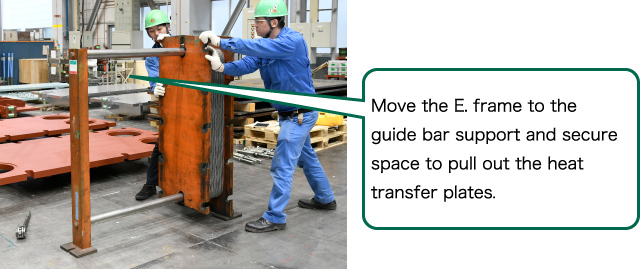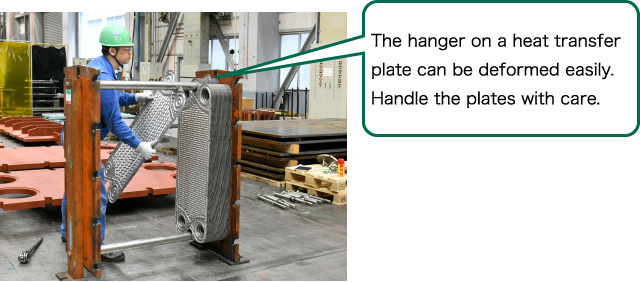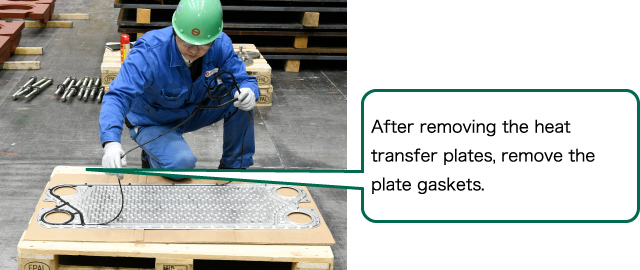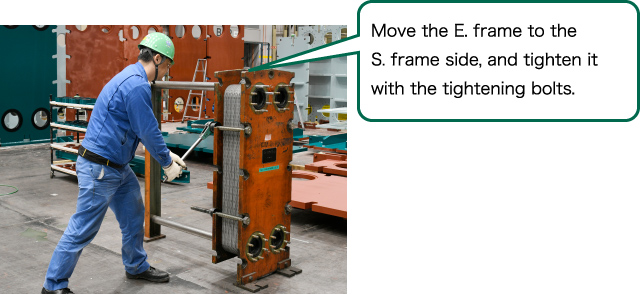Self-Maintenance
Plate heat exchangers have a simple structure which is very suitable for self-maintenance.
However, incorrect maintenance might cause fluid leakage or insufficient performance.
Perform maintenance according to the maintenance procedure.
Maintenance Procedure
0. Maintenance preparation
- Make sure that the pressure inside the equipment is low.
- Sufficiently drain the fluid inside the equipment.
- Provide protection for the area around the equipment.
- Make sure that you have all the parts required to perform maintenance.Click here for details
- If a problem occurs, make a record of the conditions (location and degree) at that time.
*We recommend taking photos and/or video.* - Before starting maintenance work, read the instruction manual carefully that came with the equipment.
You can also view the instruction manual on the following page.Click here for details - The edges of the heat transfer plates are sharp. Wear protective equipment (such as cut-resistant gloves) and perform this work safely.
1. Open the equipment

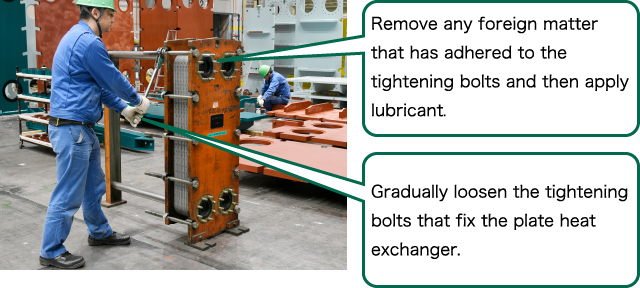 Remove any foreign matter that has adhered to the tightening bolts and then apply lubricant.
Gradually loosen the tightening bolts that fix the plate heat exchanger.
Remove any foreign matter that has adhered to the tightening bolts and then apply lubricant.
Gradually loosen the tightening bolts that fix the plate heat exchanger.

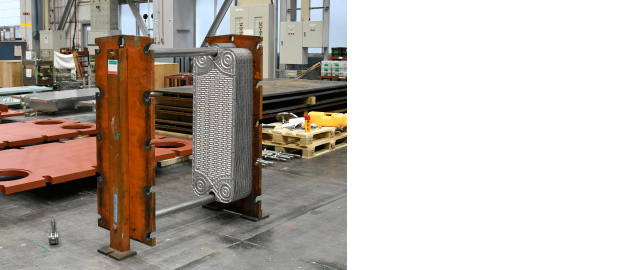
* If there is piping on the E. frame side, remove the piping before performing this work.
2. Remove the heat transfer plates and plate gaskets

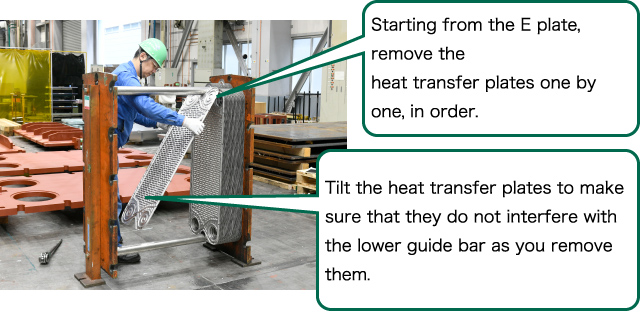 Starting from the E plate, remove the heat transfer plates one by one, in order.
Tilt the heat transfer plates to make sure that they do not interfere with the lower guide bar as you remove them.
Starting from the E plate, remove the heat transfer plates one by one, in order.
Tilt the heat transfer plates to make sure that they do not interfere with the lower guide bar as you remove them.
* During assembly, use a pen to mark the area on each heat transfer plate that does not come into contact with fluid, such as the hanger, to avoid confusion during plate arrangement and to make it easy to identify the top, bottom, front, and back of the plates.
3. Clean the heat transfer plates
Use a deck brush or a jet cleaner to clean the heat transfer plates.
When using a deck brush, be careful not to scratch the heat transfer plates.
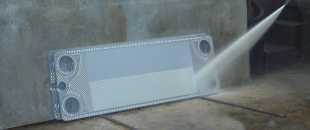

* Thoroughly clean the mounting parts (seal lines) on the plate gaskets, and make sure there is no residue. Otherwise, leakage might occur.
4. Attach the plate gaskets
After disassembling the plate heat exchanger, we recommend replacing the plate gaskets.
For details about how to attach plate gaskets for each model, see the following page.Click here for details
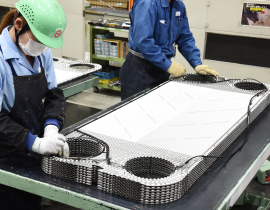
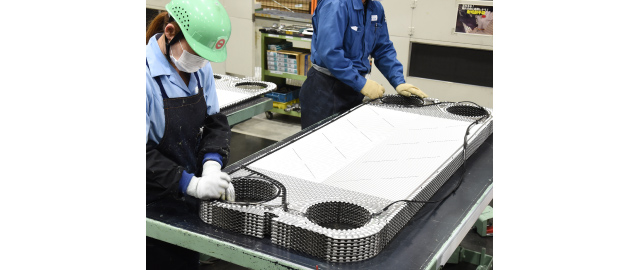
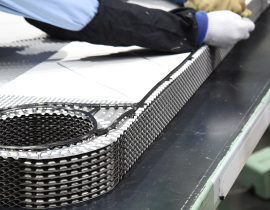
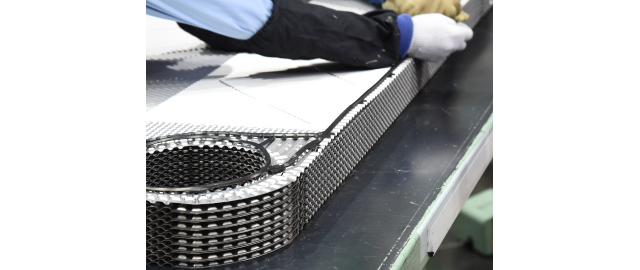
5. Assemble the equipment

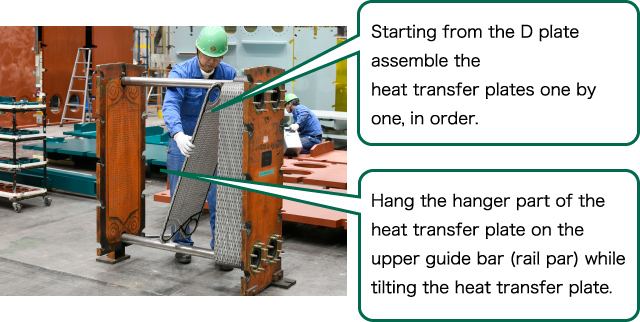 Starting from the D plate assemble the heat transfer plates one by one, in order.
Hang the hanger part of the heat transfer plate on the upper guide bar (rail par) while tilting the heat transfer plate.
Starting from the D plate assemble the heat transfer plates one by one, in order.
Hang the hanger part of the heat transfer plate on the upper guide bar (rail par) while tilting the heat transfer plate.
* After installing all of the heat transfer plates, check the plate gaskets for peeling and adhesion of foreign matter, and make sure they are not falling off or dropping out.

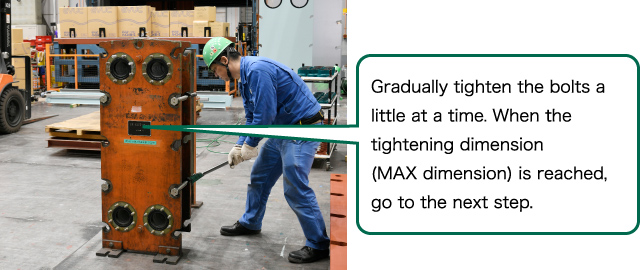 Gradually tighten the bolts a little at a time. When the tightening dimension
Gradually tighten the bolts a little at a time. When the tightening dimension (MAX dimension) is reached, go to the next step.

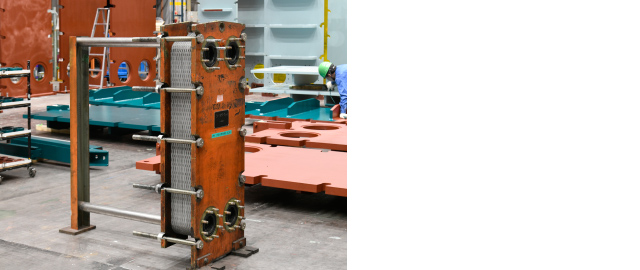
6. Inspect the equipment
1. Check for internal leaks
Remove the piping from the heat exchanger, and attach test flanges to all inlets and outlets.
- Inspection medium: Compressed air
- Increase the pressure on one side (the B side).
- Release one side (the A side) to the atmosphere.
Inspection procedure
1. Increase the pressure on one side (the B side) to 0.55 [MPa]. (Maintain for 5 minutes.)
2. Place a soap film across the opening on one side (the A side).
* Apply the soap film after the pressure has been increased and maintained for 5 minutes.
![]()
If the soap film expands, there might be internal leakage due to plate damage.
Disassemble the heat exchanger and check the conditions of the heat transfer plates.
2. Check for external leaks
Attach test flanges to all inlets and outlets on the heat exchanger.
- Inspection medium: Compressed air or water
- Increase the pressure on one side (the B side).
- Release one side (the A side) to the atmosphere.
Inspection procedure
1. Gradually increase the pressure on one side (the B side), until the design pressure is reached. (Maintain for at least 20 minutes.)
2. Check for external leaks.
If the inspection medium is compressed air (air)
Apply soapy water to the entire side of the heat transfer plate and visually check for bubbles.
If the inspection medium is water
Visually check the side or bottom of the heat transfer plates for water leaks.
* After cleaning and drying the foundation of the heat exchanger, lay down newspaper, etc. to make it easy to see water leaks!
![]()
If bubbles or water leakage is discovered, there might be external leakage due to improper gasket installation or consists of unwanted material
Once you find the location of the leakage, disassemble the heat exchanger and check the equipment.
3. Reduce the pressure inside the heat exchanger.
4. Check the opposite side (the A side) in the same way as the B side.
If it is difficult to remove piping
Close the valve near the heat exchanger to disconnect it from the surrounding piping.
Inject compressed air (air) or water from the pressure gauge seat or thermometer seat on the piping, and then perform the same inspection as above.
* Since there is a possibility of minor fluid leakage from the closed valve, performed this inspection with the piping attached poses a risk to the soundness.
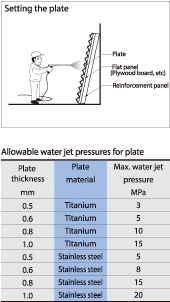
To prevent the deformation of plates and damage to sealing surfaces, set on the smooth plate and the reinforcement plate on top of each other and perform this work from a distance of 200 mm or more.
Check method 1: Pneumatic test
It is simple and easy to check the damage of the heat transfer plates without disassembling the heat exchanger.
Check method 2: PT inspection of heat transfer plates
This method is more accurate, because it is performed after removing foreign matter adhered to from the surface of the heat transfer plates and removing the plate gaskets.
Before performing self-maintenance!!
One of the major advantages of plate heat exchangers is the ease of maintenance. They can be disassembled simply by removing the tightening bolts, which makes it easy for customers to replace parts and clean plates themselves.
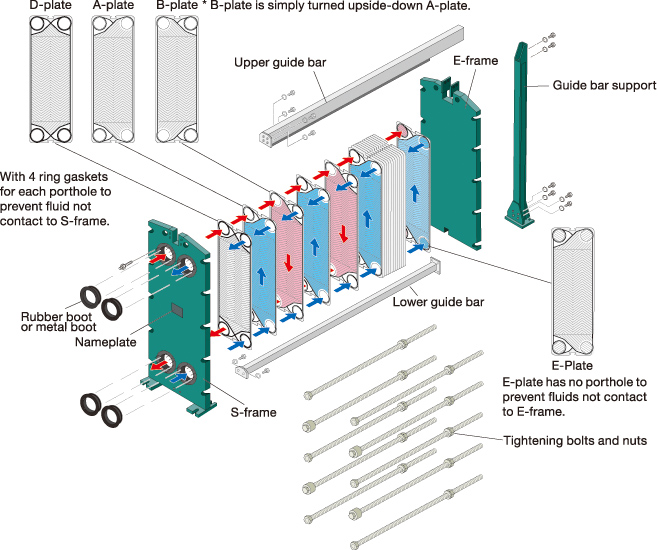
However, performing maintenance yourself comes with the following risks.
(1) Leaving scale residue due to incomplete cleaning of heat transfer plates
(2) Overlooking pinholes caused by small corrosion and cracks
(3) Causing damage to heat transfer plates due to excessive tightening
(4) Incorrectly installing the heat transfer plates
- Contact HISAKA whenever maintenance is required.
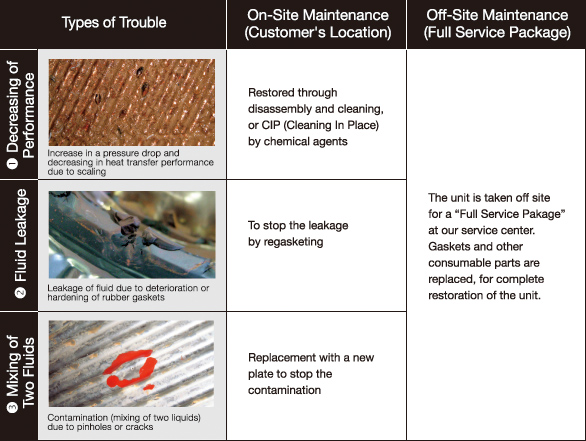
- If something still seems strange even after you have performed maintenance, such as leaking, mixture of two fluids, or insufficient performance, please contact HISAKA for assistance.




